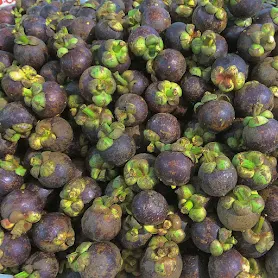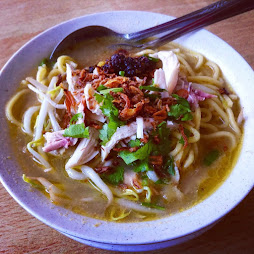Durians are tropical fruits. Considered by many as King of fruits of South-East Asia. Whether durian is the most favourite fruit here, that is a bit subjective given its' famous pungent smell that some find simply overpowering. It has that distinctive special smell or odour, that you can smell a kilometre away. Ok, that's an exaggeration. Probably 10 metres away. Some loath it, many love it. Green and thorny outside. Yellow, soft and fleshy inside. Do you know that that there are durian trees in Singapore and durian is indeed native to Singapore? A street named Lorong Lew Lian bears testament to it. Lew Lian is a Hokkien word for durian. There used to be durian plantations in the vicinity of Lorong Lew Lian (Lew Lian Lane).
The scientific name for durian is
Durio zibethinus. Duri is a Malay word for thorns, hence the name durian which means thorny fruit. And yes you can find durian trees in
Pulau Ubin and at Mandai and some odd ones at other parts of Singapore as well. During durian season you can spot the distinctive green-shelled thorny fruits up in the trees. Durian is native to Malaysia, Indonesia, Borneo and of course Singapore. While visitors to this island may find durian exotic, this fruit has been consumed for centuries.
Do you know that when the British arrived in Singapore in the early 19th century they found durian trees at
Fort Canning Hill? Apparently durian trees have existed in Singapore since the 14th century and durians were consumed by the ancient inhabitants and kings that live on Fort Canning Hill. There is a specimen of durian tree at Fort Canning Hill at the tropical fruit orchard of Sang Nila Utama Garden. Sang Nila Utama was the first ancient king of Singapura, that gives this city its name. Prior to the 14th century, Singapore was known as Temasek or sea town.
 |
Durian trees in Pulau Ubin
|
Now most durians are imported from the neighbouring countries of Malaysia, Indonesia and Thailand as there are not enough durian trees here to satisfy the craving needs of durian lovers here. Do you know Singapore imported a whopping 9,000 tonnes of durians each year? Indeed, there are plenty of durian lovers out there! And scientifically durian has been proven to be healthy fruit with various nutrients and vitamins, just do not consume too much of it as it also contains lots of calories.
While it is green and thorny outside, it is yellow, soft and fleshy inside with custard-like texture and mango-ish in taste. With a bit of subjective smell that some likened to smelly socks or pungent that will linger for a bit while, even after you have washed your hands. The smell can even penetrate the thick thorny husk of durian!
There are many types or categories of durians and prices vary, depending on the types and grades. There are Musang King, Durian 36, Mao Shang Wang, Red Prawn, Green Bamboo, Super, XO, D24, Black Thorn, Golden Phoenix, Zhuque, Champion and Mountain Cat King. So even for Mao Shang Wang or Champion, you can have grades A or B. Hopefully XO is not named after certain brand, the one that contains alcohol, though apparently it does have that aftertaste, thus its name. In the 14th century, probably the only type of durian is the kampong durian. For many, the smallish kampong durian is still the best.
 |
| Thorny green durians (outside) |
During durian season with abundance of durians, prices may be lower than hunting for one during off-season. You can find durians at many neighbourhood stalls. You can buy them whole or already scooped up and packed by durian sellers into styrofoam so we don't have to carry the heavy thorny fruit and open it up ourselves. Though if you buy whole, vendors may charge by weight and that include the weight of the husk, so the price can be rather expensive. Fruit vendors will usually wear garden gloves or put a piece of cloth over the thorny durians to avoid the sharp thorns when opening up the fruits.
Even after opening, some may opt to wear plastic gloves when eating these fleshy durians, to avoid the smell sticking around especially if they eat on the spot at durian vendors' stalls. During durian season, many flock to Geylang Road as along that stretch of road you will find many fruits stalls. You can eat on the spot. Many vendors offer seating areas. You can pick your own durian and the stall vendor will cut open for you. You ask ask the fruit vendor to slice open a bit so you can inspect the content. During season, many will also head across the border for a
day trip to Johor Bahru to eat durians at the durian plantation.
 |
| Mangosteens |
Durians are so popular with the Chinese these days that some durian plantations in Malaysia are created for export to China as some believe the fruit to be aphrosidiac. Thus those big fleshy durians can be expensive! But many still prefer the small
kampong (village) durians. As mentioned, you can still find durian trees in Singapore at
Pulau Ubin. During season the villagers there may sell these fresh durians. If not the wild boars on the island may eat them too. Yes wild boars in Singapore love durians.
As durians are considered 'heaty' fruits, people eat mangosteen as an antidote or to complement the durian as mangosteen is considered as a 'cooling' fruit. But the durian season usually coincide with the mangosteen season. So, durian is the king while mangosteen is the queen. Whether it is really to balance the heat nobody really knows for sure as both durians and mangosteens are both sweet and nice! Mangosteens are also bit tangy and juicy. The scientific name for mangosteen is
garcinia mangostana.
 |
| Mangosteen fruit and rind |
Some people will put a bit of water in the durian shell after eating durians supposedly it helps to cool down. Due to the perceived health benefits the bitter purplish mangosteen rind can also be made into juice. The purplish mangosteen rind also contains tanning for fixing dyes. Just like durian, some hotels do not allow fresh mangosteen to be brought into the hotel room, not for the smell, rather due to the purple staining effect it might cause on the bedsheet and towels.
If you are picky or have the budget, durians can be as expensive as you want it to be but you can also get one for $10 or less. If you go to the neighbourhood or the heartland HDB areas, you can pick up two packs, even three during season, of already packed durians in styrofoam for $10. Or a pack for between $5 to $8. Even supermarkets sell them. You can pick a pack for less than $10, especially during clearance. As mentioned above costs vary depending on season, supply and demand, and where you buy it from.
 |
| Durians and mangosteens sold together |
Mangosteen typically cost between $3 to $5 a kilo depending where it comes from and you you buy them from. Both durians and mangosteens come from neighbouring South East Asian countries like Malaysia and Thailand. Due to distance and perhaps types the ones from Malaysia are less expensive. And during durian season, many Singaporeans flock across the border to Johor Bahru for their fix of fresh durian. Durians and mangosteens are tropical fruits. As for me any durian will do as long as its yellow, fleshy and smell what durian should smell. The flesh of durian seeds is called arils and they can be consumed fresh or preserved by drying.
Other than eating the flesh on its own which is the best way to enjoy durians, durians are also used to flavour food products such as ice-creams, cakes, candies and even cookies. You can also find them in desserts such as the perennial local favorites,
chendol and ice-kacang. |
| Fleshy pulp, soft yellow durians |
Durians can also be made into
pulut durian (
pulut is glutinous rice in Malay) or added into
bubur kacang (green beans
congee or porridge). A Malay speciality durian dessert is
serawa durian, also called
pengat durian, which is steamed glutinous rice dipped into durian porridge. And many bakeries sell durian puffs. Just like custard puff. Even MacDonalds have that occasional durian fudge in their cafe menu. Yes, only in South-East Asia.
Dried durian flesh has also been made into durian chips while the seeds can be consumed after they are boiled, roasted or fried in coconut oil. In Java, Indonesia, the seeds are also cooked in sugar and eaten as a sweet treat. So you have not been to Singapore or South-East Asia if you have not tried durians! They are so yellow, fleshy and delicious. Calories rich, sweet and delicious.
 |
| Durian in styrofoam |
By the way, because of its odour that some likened to smelly socks, or an onion, you cannot bring durians inside MRT trains or public buses. And many hotels and airlines prevent people from bringing them into the hotels or onboard. If you can get them vacuum packed then perhaps it is possible, but then you have to wait till you get home to enjoy fresh durians. You certainly can bring home dried durian chips, candies or cookies! Just like jackfruits, there are durian chips sold in supermarkets.
Fun facts: Do you know that bats are the main pollinators of durian flowers and without them the durian trees will not bear any fruit? This is a great example of the importance between plants and animals in our ecosystem. 75% of the world's crop are pollinated by bees, butterflies, wasps, flies, birds and bats. The flowers of durian trees are bright yellow blooms that exude strong odours when they blossom at night, thus attracting the bats which are its main pollinators. Interesting isn't' it? Durian trees can grow up to 40m (131 ft.) tall. But young trees begin to fruit only around seven years of age and the fruits take about three months to develop. So how do you pick the fruits from the trees? You don't.
 |
| Mangosteens on rock at Sentosa Island |
Durian fruits will fall to the ground only when it's ripe. When left undisturbed, the fruit will split open into five pieces. This gives animals or wildlife easy access to the flesh and seeds. The animals then help to disperse the seeds. Another great example of the importance of animals in our ecosystem. Animals love durians too. Wild boars have been seen enjoying durians at Pulau Ubin and at Mandai.
Both the durians and mangosteens have been immortalised as pretty street arts painted on rocks at Fort Siloso,
Sentosa Island, by none other than by well-known local street artist Yip Yew Chong. He also painted a
wall mural of a girl enjoying durian at
Chinatown. You definitely can buy durians at Chinatown, though the price tend to be higher, it being a touristy area now.











Comments
Post a Comment